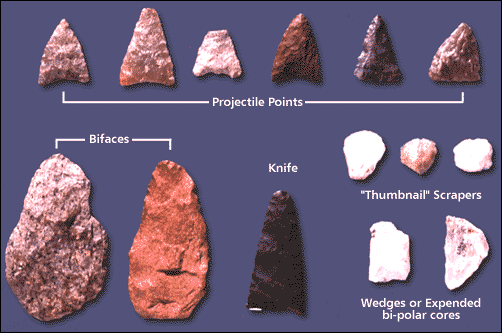First Arrivals
Archaeologists use the term "Palaeo-Indians" (paleo=old) to refer to the first people to reach North America from northeast Asia. The commonly held belief that this event took place about 12,500 years ago is now being challenged by new evidence, some of it compelling, that suggests that humans may have arrived in what is now Alaska several thousand years earlier. Moreover, some archaeologists have suggested that there were at least two waves of population eastward from Asia to the New World. Finally, the traditional picture of these ancient hunters travelling southward in what is now interior western Canada has been complicated by new suggestions that early humans travelled southwards along Canada's northwest coast before they spread eastward throughout the rest of North America.
Except for parts of the arctic, Newfoundland and Labrador was perhaps the last place to be populated by human groups. This is partly because most of the province was covered by glacial ice until as recently as 11,000 or 10,000 years ago and partly because the route of humans to this province involved crossing the continent far to the south, in what is now the United States and then returning north along the east coast where they hunted land mammals and, almost certainly sea mammals and other marine resources.
Paleo-Indian Settlements
By about 10,000 years Palaeo-Indians were settled in Nova Scotia, especially at the large Debert site and their distinctive tools and weapons have also been found in New Brunswick and Prince Edward Island. A series of small spear or dart points from Prince Edward Island bear a strong resemblance to the earliest artifacts found along the north shore of the Strait of Belle isle in what is now Labrador. Archaeologists believe that this is no coincidence and that the first Labradorians crossed the St. Lawrence, trended eastward along the Lower North Shore until they arrived in Labrador where humans had never before set foot.
Dating early sites along the Southern Labrador coast is helped by the fact that the great weight of glacial ice, up to a mile thick during the last ice age, actually depressed the surface of the earth. When the glaciers retreated the land began to rebound and beaches and archaeological sites that were at sea level slowly rose to higher and higher elevations relative to the sea level. Therefore, the older sites should be at the highest elevations. This has proven true in southern Labrador where the earliest site known in the province is now about 27 meters above sea level. A radiocarbon date of almost 9,000 years ago confirms the geological age estimate.
Located in the town of Pinware on the Labrador Straits, the site was directly on the coast at the time it was occupied, and both land and sea mammals, along with sea birds and fish were likely exploited. No bones to confirm this suggestion were found at the site, but they have been found at somewhat more recent encampments. Also found at Pinware were many of the small spear or dart points that resemble those from the Maritimes as well as knives, scrapers and thousands of waste flakes from tool manufacture, mostly of local white quartz or red quartzite. Many of the dart points have their bases thinned in exactly the same fashion as those made by the earlier people of the Maritimes had done.

Some of these first people continued to expand slowly northward along the Labrador coast but the best evidence of the earliest occupation is found in the Labrador Straits region. A series of small campsites, progressively lower in elevation and more recent in time is found between Red Bay and into adjacent Quebec. With time new elements were added to their culture (or at least have been preserved so archaeologists could find them) including polished stone axes and adzes, antler toggling sealing harpoons (perhaps the world's oldest), bone daggers and spear points, the use of red ochre and graphite pigments and the custom of occasional human burials beneath rock mounds. Further evidence of diet has also been found at these somewhat more recent sites that date between about 8,500 and 6,000. The prey includes seals, caribou, sea birds and in one case even a walrus. Berries must have supplemented the diet as people moved throughout the year to take advantage of resources as they became available.
Although these first people seem to have deserted the Labrador Straits about 6,000 years ago, they flourished along much of the Labrador coast for the next 3,000 years where they are known to archaeologists as the Labrador Archaic, a people who continued to become more intimately familiar with the Labrador during the centuries that they were the only humans in Labrador.




